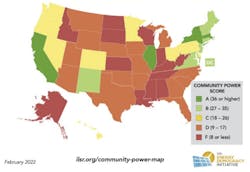Microgrids are part of a growing ecosystem of “local energy” that allows individuals, cities and communities to build energy wealth. In the US, state rules heavily influence how well local energy thrives.
A new scorecard by the Institute for Local Self-Reliance (ILSR), a national research and advocacy organization, ranks California, Massachusetts, New York and Illinois as the top states for policies supporting local clean energy. Nine other states and Washington D.C. scored above average, nine were average, 15 mediocre and 13 states failed.
Now in its fifth year, the local energy scorecard differs from other clean energy rankings, of which there are many, in that it focuses on policies that realign the economics of clean energy.
“Most state legislators look at energy policy through a 100-year-old lens. Electric utilities have a monopoly granted decades ago, or, where competition has been introduced, certain companies have sole control over access to the grid. This outdated assumption contradicts a national commitment to free markets and allows increasingly unnatural private monopolies to persist,” the organization says in a document explaining its reason for producing the scorecard.
The local energy scorecard “values state policies that build wealth and enable community ownership by creating choices for customers,” the organization writes. “These policies capture and support the ongoing structural and technological transformation in the energy sector — in other words, decentralized, distributed, democratized energy production.”
Important to microgrids
The ILSR considers several policies that are particularly important to microgrids such as friendly interconnection procedures and rules that allow distributed energy to count toward meeting renewable portfolio standards (RPS).
At the same time, the scorecard sometimes diverges from microgrid interests — or focuses on programs that are indifferent to microgrids. For example, it penalizes states that preempt local decision-making on connecting new construction to gas infrastructure. Such bans can have negative consequences for microgrids that use natural gas.
Still, the scorecard indicates that states that support local energy are likely to be those where microgrids thrive. California, Massachusetts and New York are vibrant states for microgrid development. Illinois is a microgrid innovator where a highly watched microgrid cluster is emerging.
Failing states or those with low grades tend to be in the southern and central states, while higher scoring states could be found in the Northeast, Mid-Atlantic and California — another pattern that tends to mimic microgrid activity.
Alaska was a clear exception. The state has a large number of microgrids but received an “F” in the scorecard. A series of zeros for policies governing community aggregation, feed-in tariffs, RPS carve-outs, shared renewables, third-party ownership of solar and preempting natural gas bans drag down the state.
Carving out distributed energy
The scorecard features four states that allow, or require, that utilities secure a certain amount of distributed energy to meet RPS requirements. They are Minnesota, New Jersey, Arizona and Maryland.
Minnesota requires that 1.5% of utility electricity sales come from solar and offers an incentive for projects 20 kilowatts and smaller.
New Jersey requires utilities to provide 50% renewable energy by 2030, with a carve out for solar energy.
In Arizona, utilities must meet 30% of the RPS (15% by 2025) from distributed generation, with half from residential customers.
Maryland mandates that about one-third of the RPS energy procured (14.5%) comes from solar. Maryland has an interesting penalty system. If a utility fails to meet its RPS mandate, it must make compliance payments to benefit solar projects that are owned by low-income residents.
For interconnection — another issue important to microgrids — states that received the highest points were California, Illinois, Massachusetts, Minnesota, New Mexico, Ohio, Oregon, Utah, and Virginia.
Local energy scorecard
The full ILSR community power scorecard is available here.
Track news about microgrids. Subscribe to the free Microgrid Knowledge Newsletter.
About the Author
Elisa Wood
Editor-in-Chief
Elisa Wood is the editor and founder of EnergyChangemakers.com. She is co-founder and former editor of Microgrid Knowledge.
